Medical Practices Must Reduce Patient Wait Times—Here's How
Nearly two out of every five patients are frustrated with their doctor before their check-up even begins. Why do so many appointments start off on the wrong foot?
Well, the average patient wait time for healthcare organizations across the country is around 20 minutes—and that just won’t fly for a large portion of patients we surveyed.
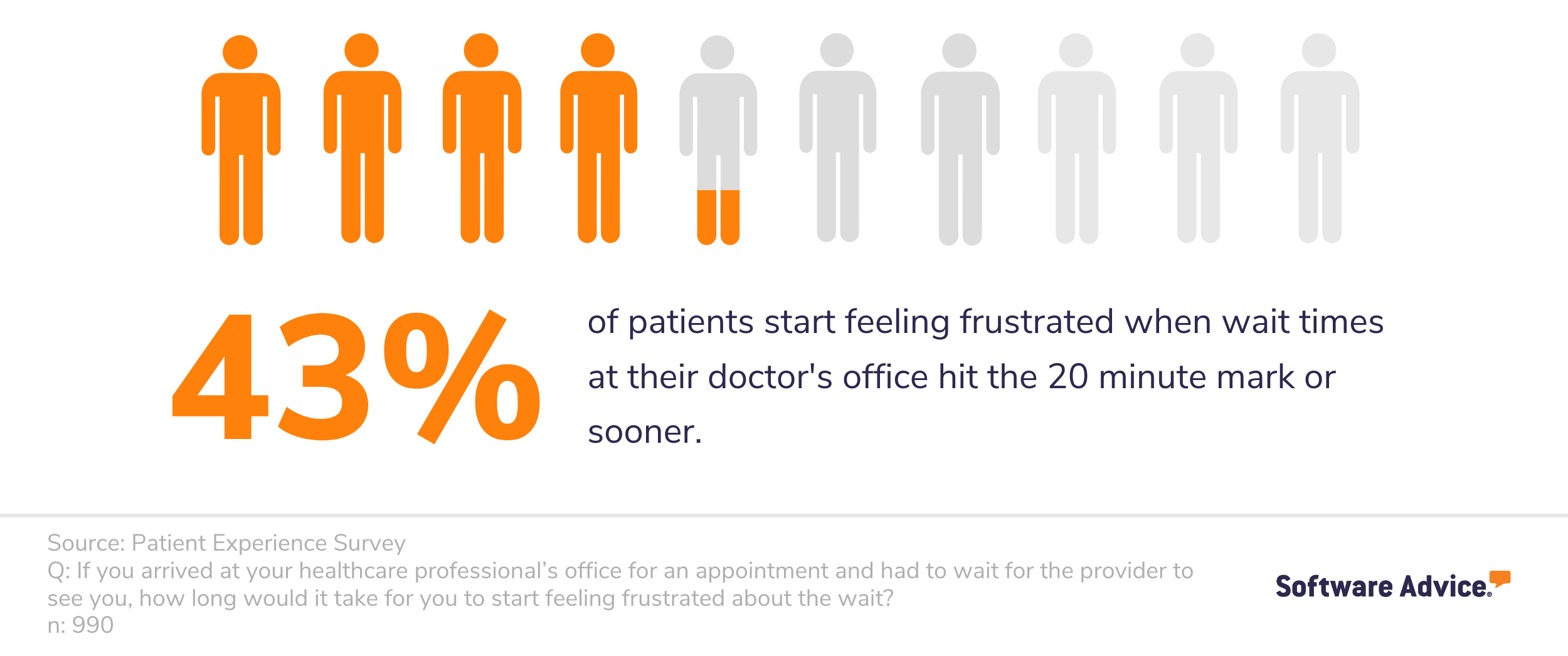
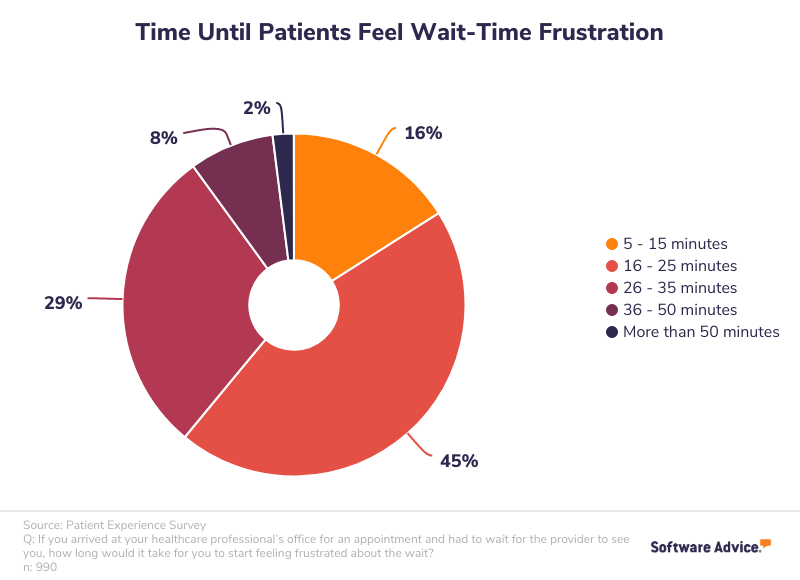
Practices that fail to address these wait-time frustrations stand to lose up to 48% of their patient base in a year—and that’s not counting potential patients who avoid your practice after learning about long wait times through online reviews.
Failure to implement solutions in your waiting room will severely impact your ability to retain, attract, and satisfy patients.
In this research report, we’ll show you data that supports this claim, plus provide actionable advice and tech tools to help you improve patient satisfaction and keep patient scheduling on track.
We ran two separate studies to help gain a better understanding of the complex issue of patient wait times:
Key findings
More than half of physicians surveyed say patients experience wait times longer than 20 minutes “often,” and 61% of physicians have heard negative feedback from their patients regarding wait times.
A combined 63% of physicians believe wait times have “no impact” or “minimal impact” on their ability to retain patients; however, 24% of patients say they’ve changed doctors because of long wait times.
Sixty-four percent of physicians say patient arrival times (e.g., patients arriving later than their scheduled appointment time) are usually the biggest reason they run behind schedule.
Eighty-three percent of patients say being told in advance what the wait time will be could help to reduce frustration.
Wait times are like circus acts (no, really)
Circuses often feature risky balancing acts. So do medical practices—in the form of wait times.
Here’s the balancing act for physicians: Schedule enough patients per day to cover practice costs, but try not to overbook the agenda. This is tougher than it sounds, considering health care providers must account for the unexpected, such as last-minute cancellations and no-shows.
No-show patients cost around $200 per unused time slot, and the average no-show rate for most U.S. practices hovers around 20%.
That’s a lot of lost revenue, so it’s understandable for practices to schedule as many patients as they can to mitigate the financial losses from missed appointments.
However, it’s also important to ensure wait times aren’t routinely long, because practices run the risk of upsetting the scheduling balance and causing patient satisfaction rates to crash.
In our physician survey, we asked respondents how often a patient at their practice encounters a wait time that is longer than 20 minutes for a scheduled appointment. Twenty-five percent said “daily” and 28% said “at least once a week.”
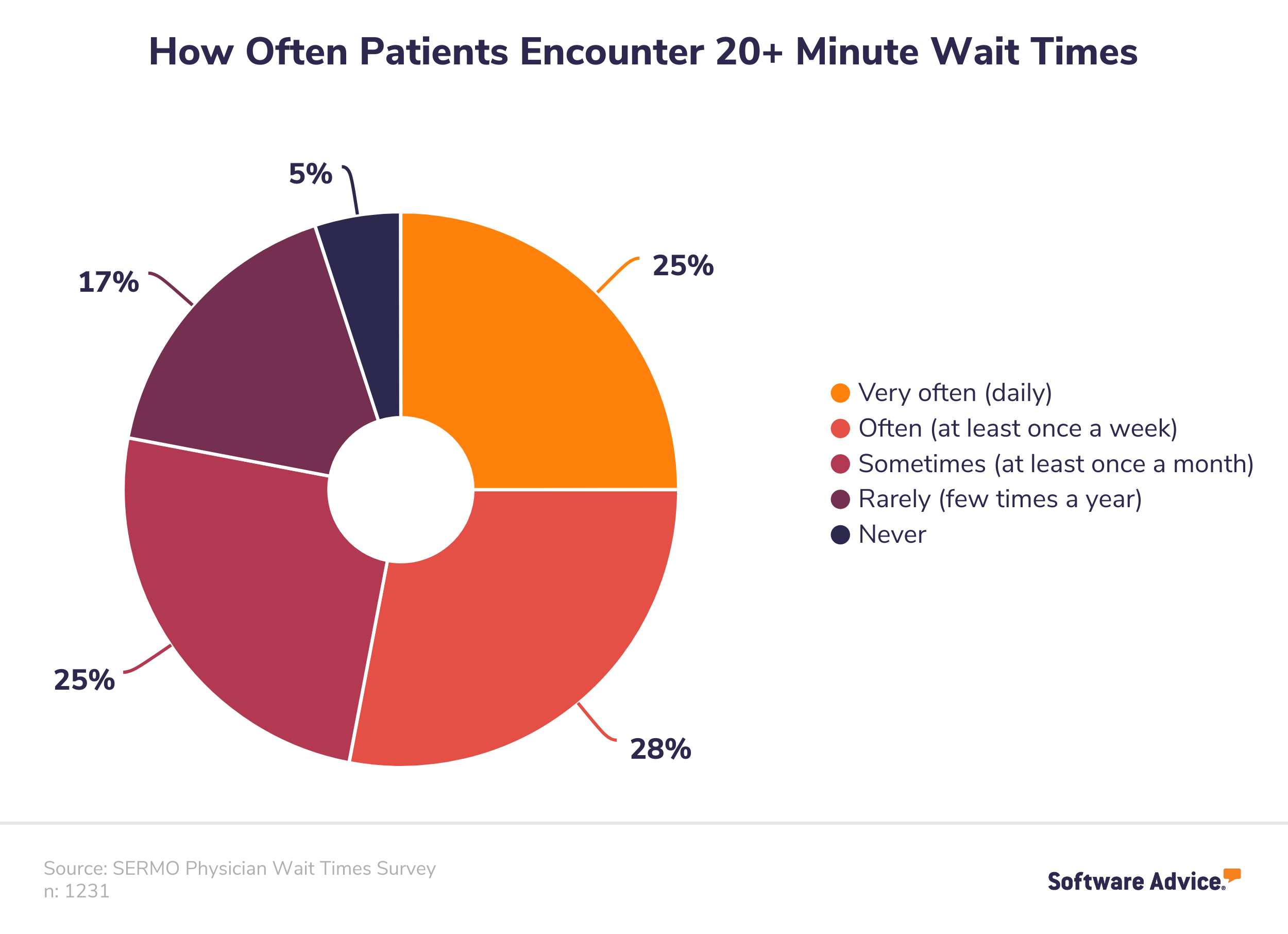
Given this finding, we weren’t surprised to learn that over half of physicians we surveyed have heard negative feedback from patients about wait times at their practice.
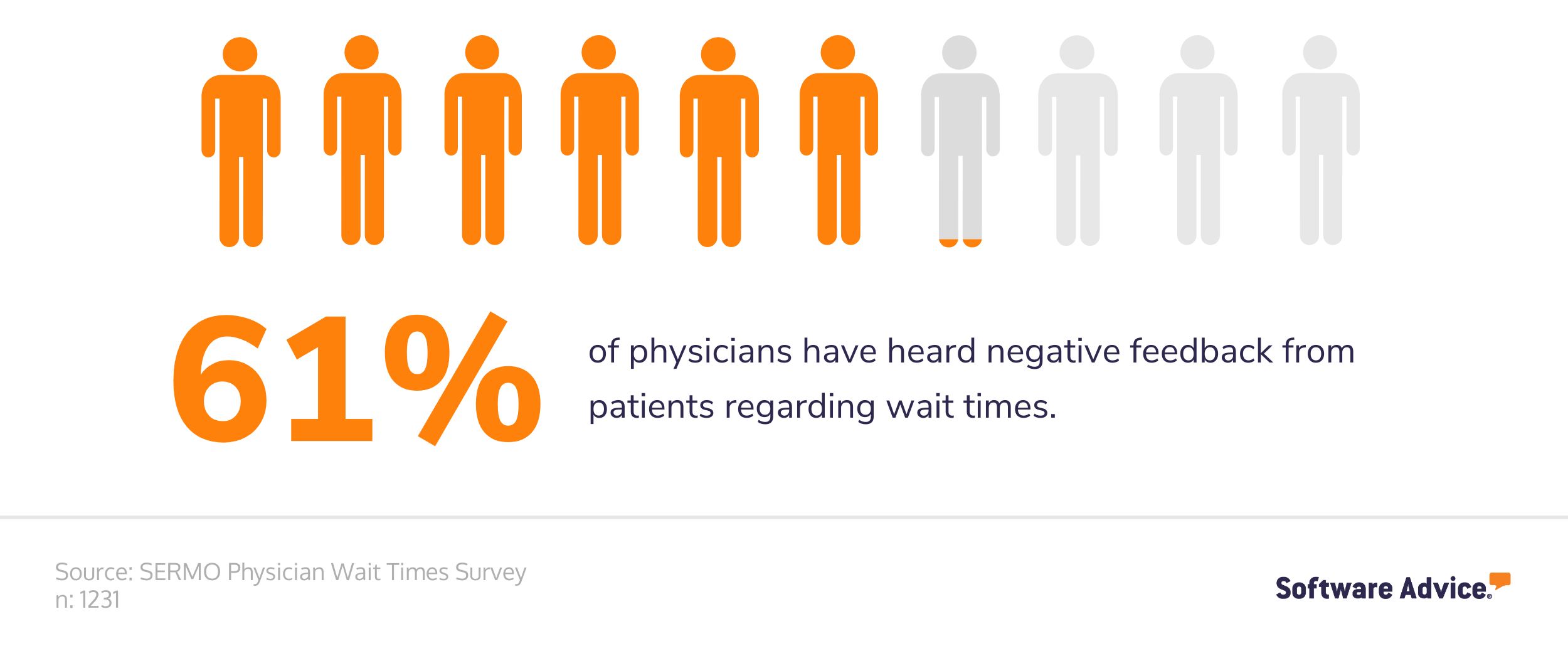
Why you can’t afford to have long wait times
One reason lengthy wait times are still so prevalent is that many physicians simply don’t see them as an issue.
When asked how big of an impact they think patient wait times have on their practice’s ability to retain patients, 12% of physicians claimed “no impact at all” and 51% predicted a “minimal impact.”
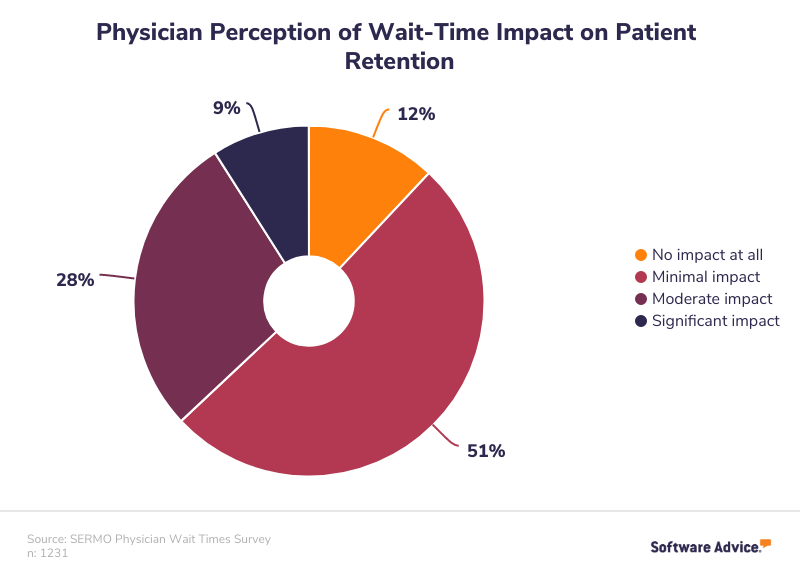
That perception is contradicted by the results of our patient survey, which indicate that wait times do have a tremendous influence on whether people are loyal to a practice.
Here’s what we found when we asked patients how they’ve behaved after experiencing long wait times at a doctor’s office:
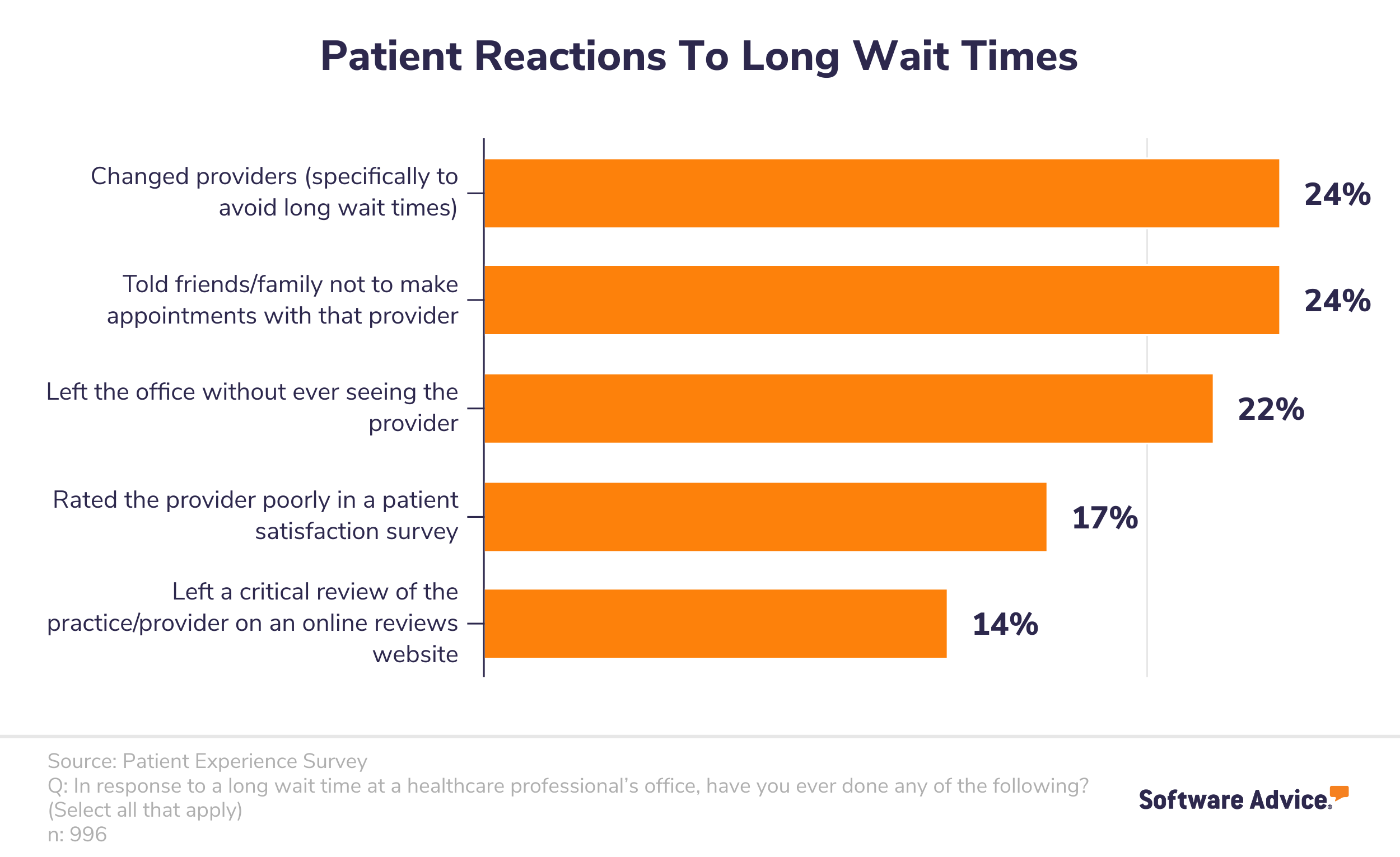
Nearly a quarter of patients say they’ve literally walked out of a waiting room, choosing to reschedule or even cancel rather than wait any longer.
Practices overbook patients to mitigate the effects of missed appointments, but the resulting long wait times can actually cause missed appointments.
Moreover, a patient’s negative experience with practice wait times has a ripple effect that extends from close friends and family to strangers on the internet.
Twenty-four percent of patients have discouraged their friends and family from seeing a certain doctor, and 14% have left critical comments on online review sites specifically because of practice wait times.
That’s a big deal because 41% of patients specifically look for information about wait times when evaluating new doctors through online reviews.
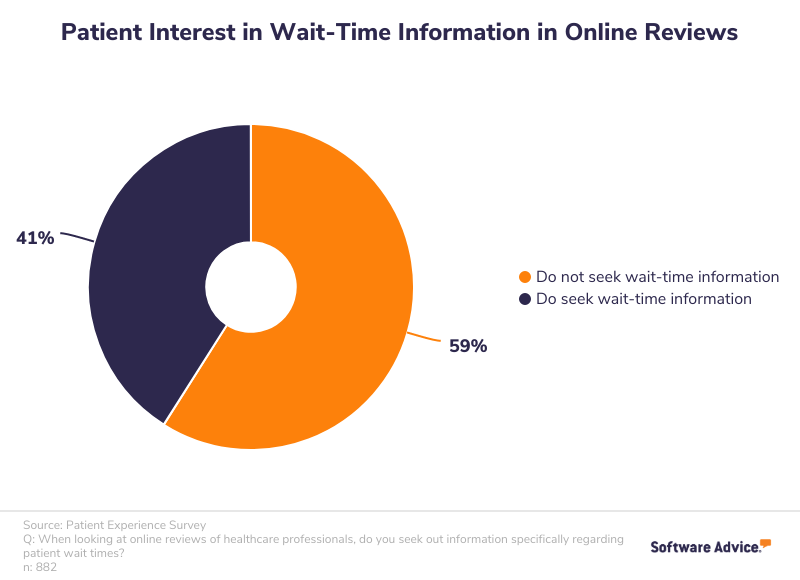
Bearing the effects of long wait times in mind, the next question we have to answer is what factors cause these long wait times and, more importantly, how can you address the issue?
Patient-related delays cause most long wait times
We wanted to dig deeper into the scheduling challenges physicians face so we could better understand the root causes. We asked physicians to select all the factors that contribute to longer-than-average wait times at their practice.
It turns out patients themselves are behind the top two causes: 64% of doctors cited patient arrival times (e.g., patients arriving later than their scheduled appointment time), and 61% cited unexpected patient issues (e.g., encounters patients requiring unique or additional documentation/treatment).
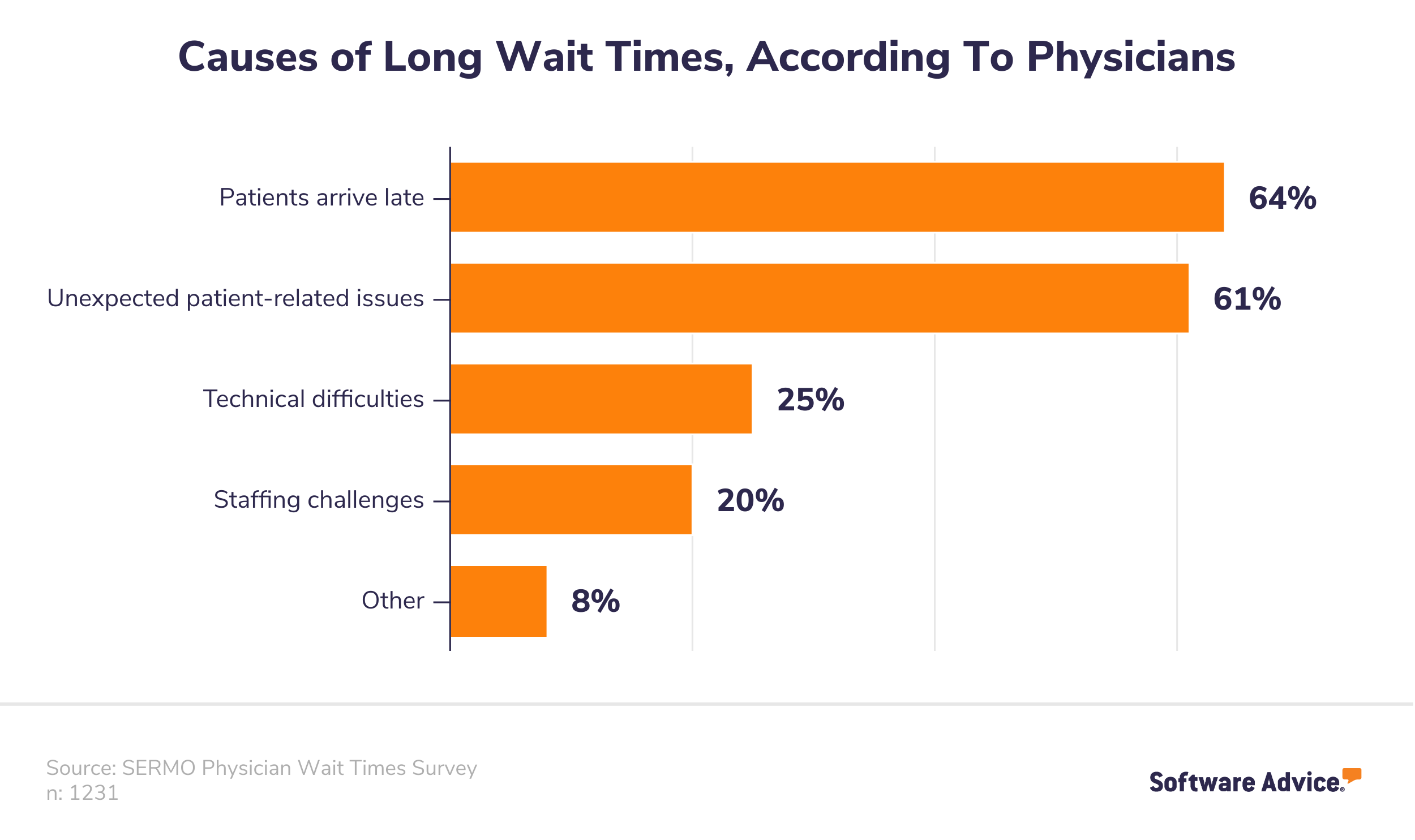
The truth is, patients are typically the ones creating those long wait times for each other.
For example, patients who arrive late to their appointments and still expect to be seen cause physicians to run behind in their schedules. Likewise, patients can book shorter appointments and then take extra time once they get in the exam room.
So, what’s the solution? Physicians can rely on a few valuable tools and strategies to help combat patient-related delays:
Leverage software to send multiple appointment reminders. You can automate these reminders to be sent via text message, email, and/or a phone call leading up to the appointment time. (Compare hundreds of systems within your budget here.)
Create, communicate, and enforce a late arrivals policy. In one Massachusetts-based practice, patients receive warning letters the first three times they’re more than five minutes late. By the fourth offense, they’re asked to find another provider.
Try to anticipate whether you’ll need to spend more time than usual on a particular visit. Ask patients to complete paperwork ahead of their visit to determine whether their symptoms appear to require additional attention. (Learn about online intake forms and patient intake software systems here.)
Tech issues cause delays too, but training can help
It’s also worth noting that 25% of physicians told us “technical difficulties” impact wait times.
These include glitches with medical software and/or delays in digitally documenting health information. EMR usability is a common complaint among doctors, including of one of our survey respondents, who writes:
Survey respondent in pediatrics
Learning a new system does take time, but your tech should be making your practice more efficient, not less efficient. To reduce software-related delays, you must first identify and troubleshoot bottlenecks in your software usage. From there, you can replace the time-consuming applications with new ones that save time.
Read more about overcoming EMR issues with these resources:
Hiring the right people makes all the difference
Two out of 10 doctors say they experience staffing challenges that influence wait times. Some respondents tell us their employees are “slow” or “not performing at the [right] level” while others say their practice is simply understaffed.
Tips for reducing staff-related delays:
Hire staff to improve wait times—even if it’s just part-time—because it could actually save you money in the long run. Long wait times are costing you patients in the form of cancelled appointments and negative word-of-mouth.
Improve employee motivation and efficiency with some of these popular strategies. These include team-building exercises/events, regularly holding performance reviews, and rewarding high-achievers with bonuses or gift cards.
Once you begin implementing these targeted strategies to eliminate specific causes of long wait times, you’ll begin to see improvement in your own schedule (and stress level) as well as your patients’ experiences.
Potential cures for wait-time frustration
Even if you implement all the advice above, you’re bound to run late once in a while. As we’ve explained, the balance between smooth scheduling and overbooking is delicate.
We asked our physician survey respondents whether they’d ever monitored patient wait times at their practice. Nearly three-quarters have—43% do so “informally”, and 31% monitor wait times through a “structured process.”
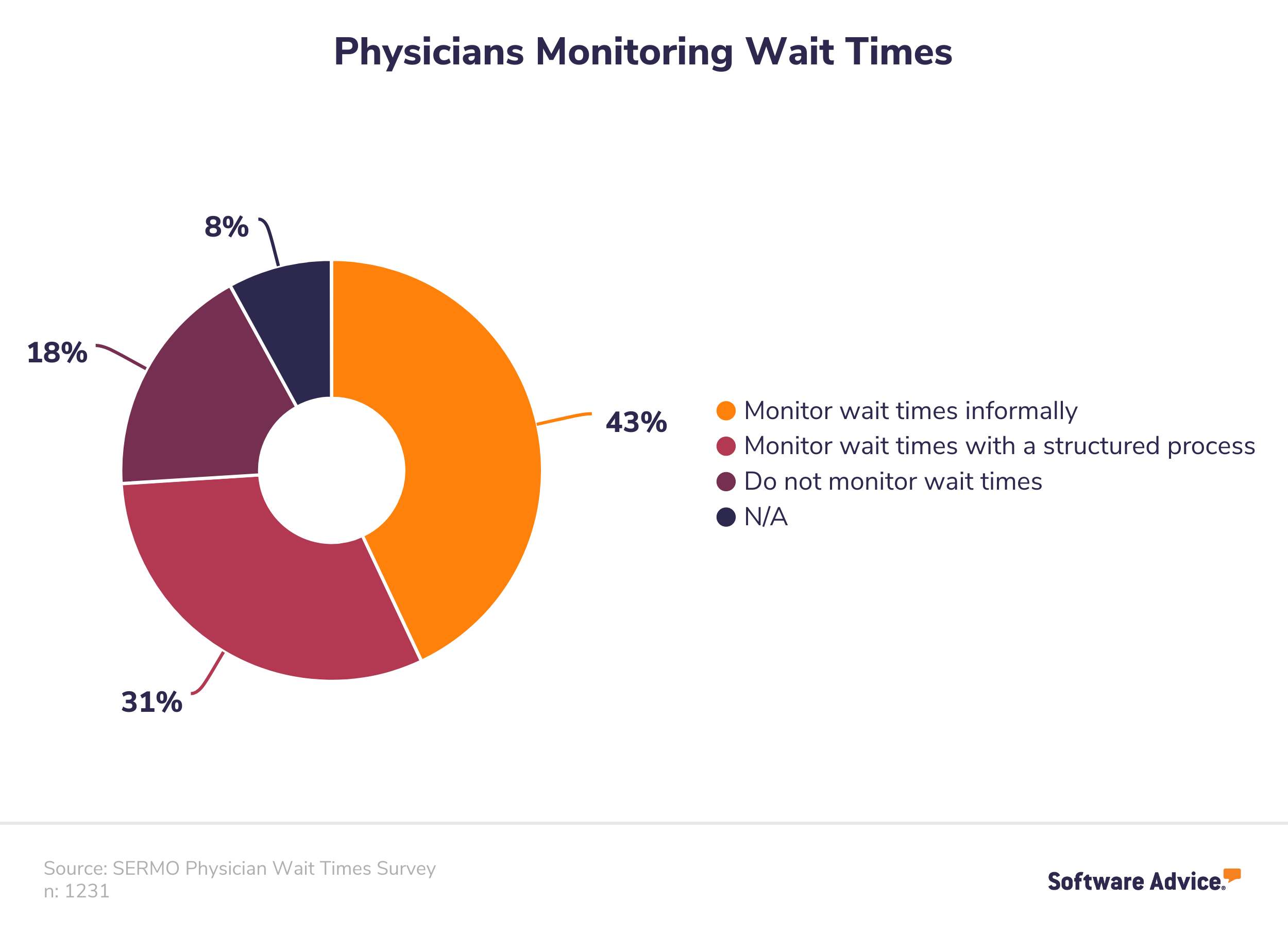
It is encouraging to see that so many physicians are already keeping an eye on wait times, though it appears there’s still work to be done in leveraging that data to drive improvements.
If you’re among the group of doctors who informally monitors wait times or doesn’t do so at all, here are some good ways to gather that information:
Invest in dedicated tracking technology: Many patient scheduling and tracking vendors can automate timers and generate reports for you.
Run a patient survey: You can ask about wait times and collect other kinds of helpful practice management feedback. Here are additional survey question ideas and implementation advice.
Assign a staff member to track times manually: They could compare patient sign-in times versus treatment start times over a predetermined period (e.g., a week or a few days a month), then report back with the findings.
Recruit volunteers or hire patient flow consultants: These people would take detailed notes about the average visit length at your practice to identify bottlenecks without straining your staff’s bandwidth.
Once you have more information about your practice’s particular wait-time challenges, you can focus on low-effort solutions to minimize frustrations whenever you do experience delays.
When we surveyed patients, a combined 83% said being told in advance how long they’ll have to wait would reduce wait-time frustration. Sixty-four percent would also find a personal apology from the doctor helpful.
These free strategies trumped higher-cost measures in our survey, such as the availability of television or reading materials.
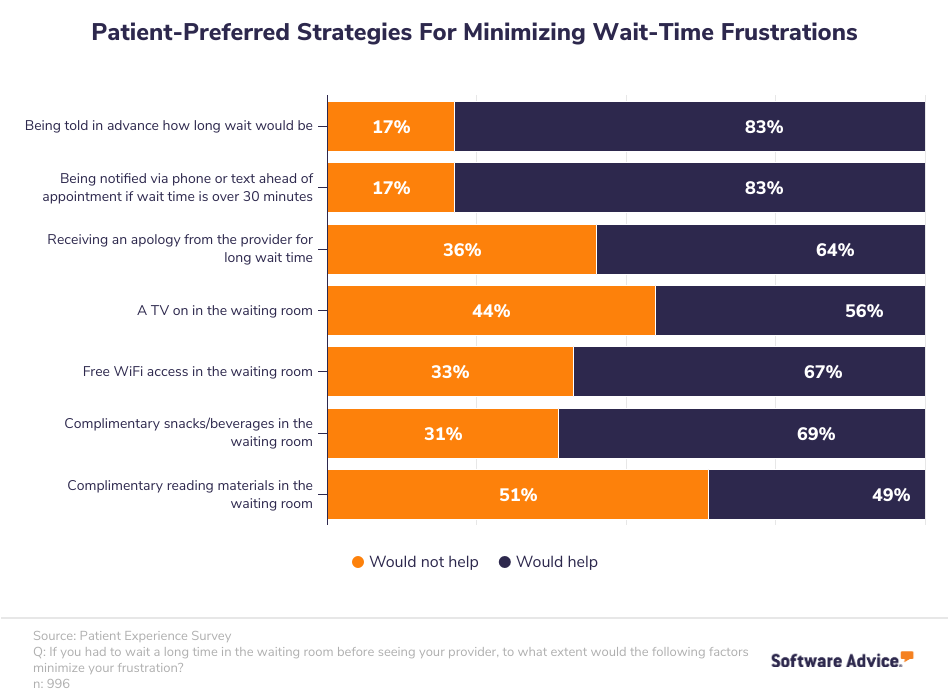
Another simple strategy for minimizing patient frustration applies to group practices in particular. When asked if they would be open to seeing another doctor in the practice if it meant a shorter wait, 72% of patients said they would.
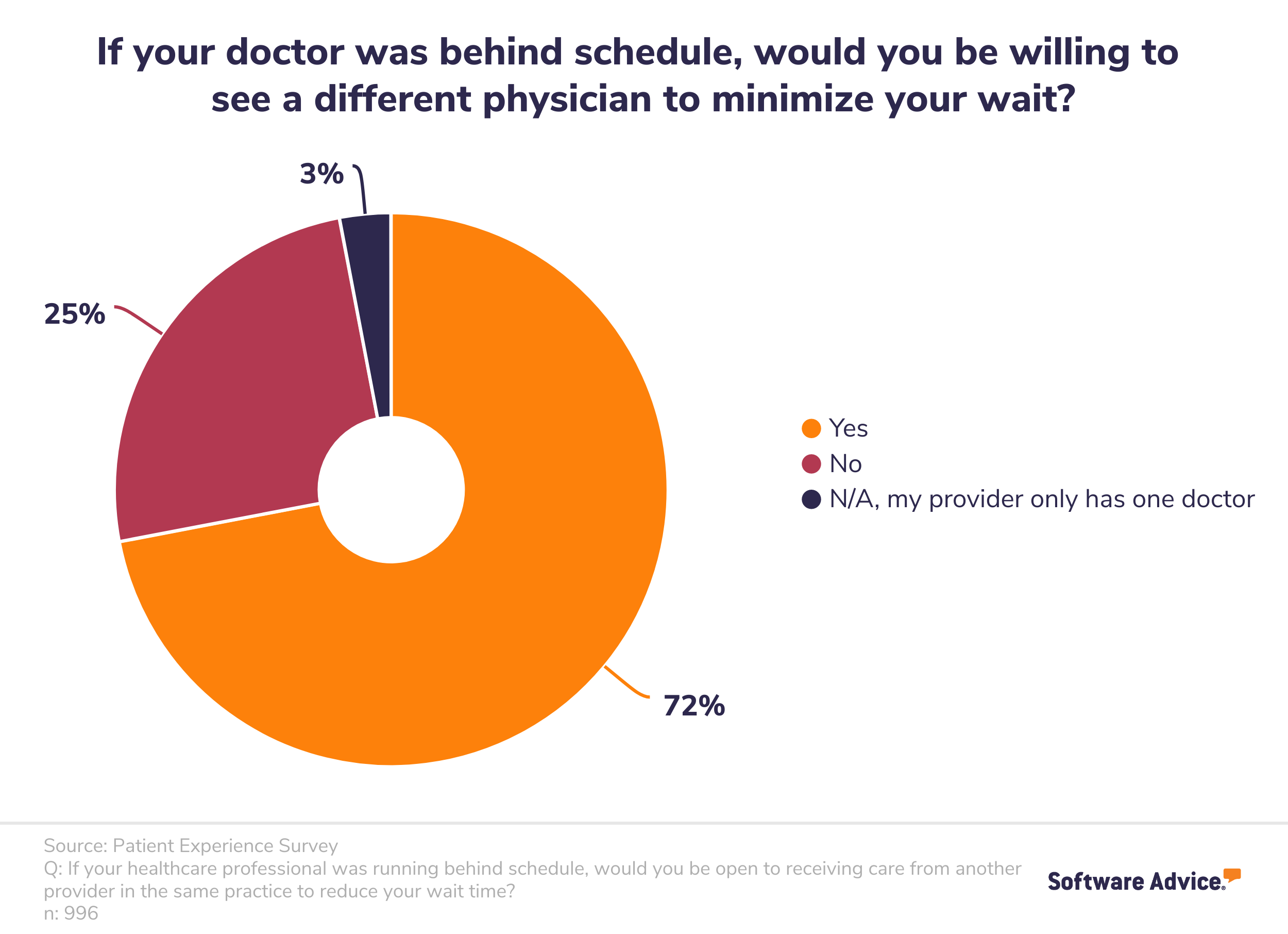
Consider extending this option to waiting patients if another doctor in your practice is available to see them sooner.
Next steps
With your practice’s profitability and reputation at stake, it’s clear that reducing patient wait times should be a priority in the management of your practice. This is especially true as patient satisfaction becomes an increasingly important performance indicator for physicians.
Here are the three main steps you can work on right now, which we’ve prioritized based on the results of our survey data:
Invest in scheduling tools that can help patients arrive on time, as well as in the right charting software to speed up your documentation process.
Monitor wait times to identify and address specific bottlenecks causing delays (e.g., patient arrival times, staffing challenges).
Be up front with patients about delays when they arrive and offer a personal apology once treatment begins.
To further discuss these findings or obtain access to any of the charts above, feel free to contact me at lisa.hedges@gartner.com.
Survey methodology
1. For our physician survey, we partnered with SERMO to poll 1,232 healthcare providers in the U.S. working in practices with between one and 25 physicians. This survey was run in 2017.
2. Our patient survey included 996 patients within the U.S. who had seen a healthcare provider within the past year. This survey was run in February 2020.
For both surveys, we used screening questions to narrow the number of respondents down to those with relevant histories and experiences. We worded the questions to ensure that each respondent fully understood their meaning and the topic at hand.
The information reported in this article has been obtained from sources believed to be reliable.
For more information, see our methodologies page. If you’d like to obtain the charts in this report, contact lisa.hedges@gartner.com.